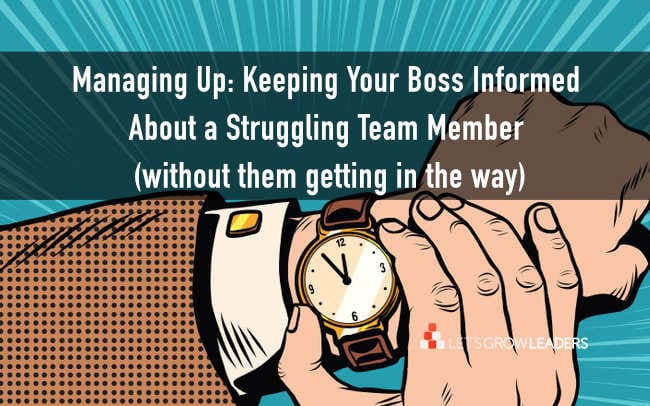Managing up is easy when performance is good, but it gets a bit more tricky when results are down. Here are a few practical ways to show your boss you are on it WHILE giving your struggling employee the time and space to turn their performance around.
How Do I Manage Up When Results are Down? #AskingforaFriend
This question came in through our learning lab in one of our live-online leadership development programs.
What’s the best way to “manage up'” when working through employee coaching and improvements?
The question brought back a rush of memories of one particularly impatient boss who wanted every performance issue fixed “yesterday” the “easy way.”
Meaning, “just fire the guy” and move on. That boss wasn’t particularly close to the complexity of the work.
And, he had a hard time seeing the long-term potential in struggling employees.
So, I learned the art of managing up when results were down the hard way.
Why This is Hard
Coaching for lasting improvement can take a minute. Your employee needs time to try new approaches and learn what works best in different scenarios.
Great coaching requires real connection, vulnerability, and trust. No one wants to feel like every conversation is being followed and tracked by someone outside the room.
And even as your struggling team member is improving, it’s likely they’re still going to screw up from time to time, reinforcing their reputation as a poor performer. It would be easy for a removed observer to prematurely conclude that your coaching’s no working, and it’s time to move on.
And of course, there’s Murphy’s law at play…even if that customer service rep you’ve been coaching to have more empathy has made major improvements, the one time she gets testy with a customer will inevitably be when your boss is walking by.
You care about your struggling employee. You care about your boss. And, you care about the long-term performance of your team. It’s hard to balance these nuanced relationships as a human-centered leader. But it is possible.
4 Steps to Keeping Your Manager Informed When AddressIng Performance Issues
You need to give that struggling employee feedback, coaching, and support while keeping your manager informed about progress in a way that gives them confidence that you’re doing the right thing for the employee and the business.
1. Set clear expectations with your employee and with your manager
Start with a shared definition of success. Ensure all three of you define what good performance looks like in the same way. Sure, start with the metrics, like making quota or attaining service level or productivity measures. And, also ensure you’re aligned on the behaviors that will lead to success.
Focus on the game, not just the score.
2. Work with your struggling employee on a clear path to improved performance
If you need help with this, these articles are rich with practical tools.
How to Provide More Meaningful Performance Feedback
How To Coach Employees to High Performance When Time Is Limited
Be sure to establish timelines and check-ins to measure progress.
3. Schedule the finish
The next step to managing up when coaching a struggling employee is to share the high-level plan with your manager and check for understanding to ensure they’re aligned with your approach.
And, here’s the part where you buy yourself the time to make an impact.
Schedule the finish. Get some time on your manager’s calendar when you will talk about the situation again. When your manager knows you have a solid plan AND they know when they’ll get an update, they’ll be less likely to ask you about progress every time they bump into you. You’ll feel less micro-managed and you have time to help your struggling team member without having to share the play by play.
4. Give them opportunities to repair their brand
This is perhaps the trickiest part of managing up with a once-struggling employee. Even if they’ve worked hard to turn their performance around and they’re nailing their role, Ii’s likely you both still have some managing up to do.
iI’s time to show your manager they’ve really changed.
Marshall Goldsmith gives some good advice on this in our recent Asking For a Friend interview (I’ve included a very short excerpt from that interview below… you can watch the rest of the show at this link.
“It’s much easier to change behavior than to change the perceptions of others. Changing the perceptions of others is hard because we all see each other in ways that are consistent with our previous stereotypes.”
An important part of your role in managing up is to help your manager see the change.
Managing Up: What if The Employee Can’t Turn it Around?
Of course, it’s also possible that despite your best efforts, the performance doesn’t turn around.
If you’ve been following this process, you have good documentation, and you’ve kept your manager informed, you’ve built trust in all directions. It’s time to move forward with the next phase of the performance management process without guilt.
Sometimes letting an employee go is the most human-centered action for all involved.
As a human-centered manager managing up well, you want to support your employees and help them to grow AND give your manager the piece of mind so they don’t need to get overly involved.
Leaders Coaching Leaders: One Secret to Sustainable Leadership Development







0 Comments